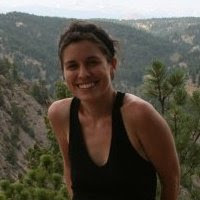The skies over the High Plains have quieted for a while. After an excellent mission targeting a squall line in Oklahoma, VORTEX2 is now in a holding pattern waiting for the weather to become active again.
The squall line mission really tested out our equipment and tactics. We set up a line of 5 mobile radars (a first), both Sticknet lines in the dual-Doppler lobes (a first), and had 14 Mobile Mesonet vehicles driving back and forth across a pre-storm boundary and the storm itself. Disdrometers were deployed, and weather balloons were launched ahead of the storms and in the cold pool behind, we even dropped our array of tornado pods ahead of the line's gust front. Even though the line did not produce a tornado in our study area, the mission was very satisfying because we really succeeded in our choreography around the storms.
Now we have a few days with no missions. But, VORTEX2 is not at rest. CSWR is working hard on software and hardware modifications so that our radars work better. So are all the other groups. The Rapid-Scan DOW's generator is still stalling sometimes, so we're trying to shield it better from road splash. One of the DOWs went to Oklahoma City to get its hydraulics fixed. On Monday it will have yet another diagnosis of its drive shaft vibrations. We have a brand new International Truck that has had major problems, and we hope that International finally replaces our bent and vibrating shaft. And, one of the Tornado Pod's T/RH (temperature/relative-humidity) sensors got bent during travel yesterday.
We are gathering together the data we collected yesterday so that we can show it to and share it with other VORTEX2 scientists. Even though there was no tornado, we need to see how well the radars performed, how well the Sticks and Pods and Balloons, etc. did their jobs, whether they were directed to the best places at the best times, whether the data were recorded correctly and were calibrated.
Also, crews have to take care of personal tasks that are nearly impossible when we're nomadic, pulling into hotels late at night and leaving the next morning, things like laundry.
Sunday, May 17, 2009
Subscribe to:
Post Comments (Atom)
Blog Archive
-
▼
2009
(14)
-
▼
May
(13)
- Backwards Storm Intercept
- Surprise supercell intercept
- VORTEX2 Goes Way North
- A few days of being stationary for VORTEX2
- No gold at the end of the rainbow yet
- VORTEX2 hits the road
- Glamour, Sciance, and the Start of VORTEX2
- Arrived in Norman for 'Media Day'
- CSWR team in Hays, Kansas
- DOWs, Mobile Mesonets, Tornado Pods on the Road
- I am writing from Boulder, unfortunately. We trie...
- <!--[if gte mso 9]> Normal 0 f...
- The VORTEX2 project is about to begin. We have be...
-
▼
May
(13)


In a way I am glad our weather has settled down, bad luck for you! But with your better understanding of how our storms produce tornados gives all of us a better change to be ahead of the storm! Thank you for your efforts!
ReplyDeleteI'm glad that things are working out for you guys. I am a geologist, and I spend a lot of my time in the field, so I know how difficult it can be to get things like laundry done, and how important it is to make sure all the equipement is working right. Best of luck with your research!
ReplyDeleteWHY OH WHY do subsistence patters show up at times like this? LOL
ReplyDeleteLove the blog and can't wait to hear more. I'd like to hear some great scientific data and information, if you don't mind sharing a bit with us.
Thank you for sharing your experience with the rest of us.
ReplyDeleteBlog is awesome, with all of these instruments you should be able to cook on any weather disturbance in an area and collect significant data that may change the way we look at any storm/atmospheric disruption, not just supercells--any chance of photos/video clips for scale/general location? Maybe a radar snapshot? Good luck and stay safe.
ReplyDeleteThanks forr writing
ReplyDelete